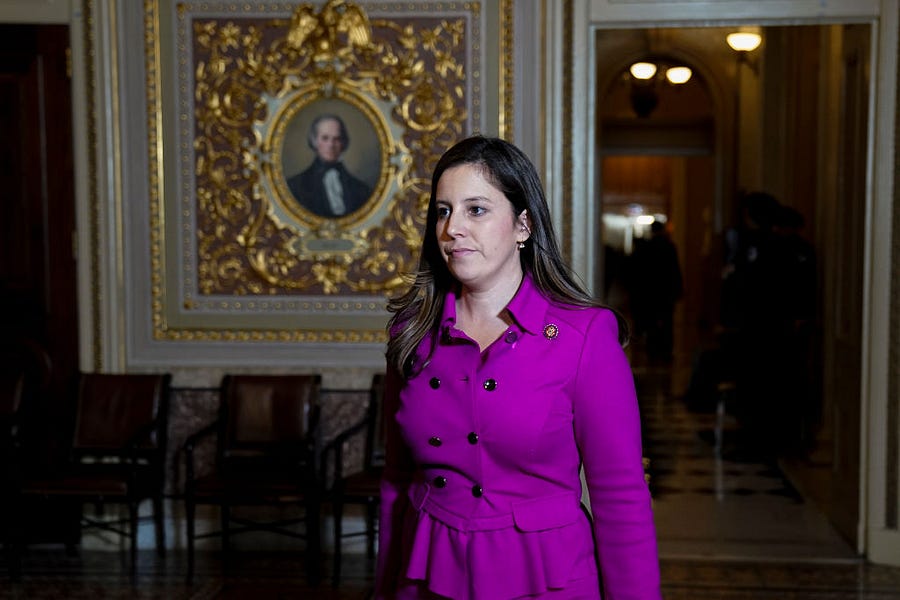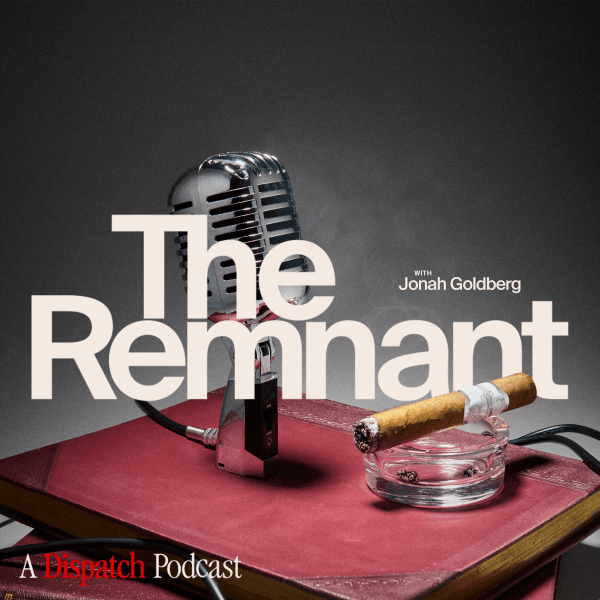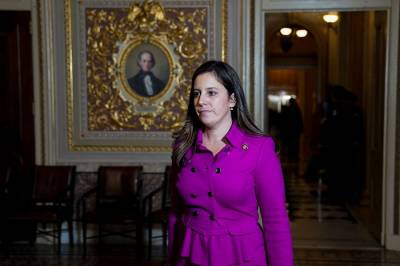When the Harvard Institute of Politics decided after January 6 to boot Rep. Elise Stefanik from its Senior Advisory Committee, it likely hurt the 36-year-old Republican more than she publicly let on.
“When we were at the IOP, we looked at that Senior Advisory Committee like they were gods on earth,” said one of Stefanik’s Harvard classmates who served on IOP leadership with her. “At the time, Ted Kennedy sat on the Senior Advisory Committee. It was stacked with former senators and congresspeople. If you could get invited to a lunch with the Senior Advisory Committee, that was perceived as the ticket when you were a student.”
The IOP—established in 1966 and housed at Harvard’s Kennedy School—is designed to imbue students with a passion for politics and public service, and it worked on Stefanik. Just weeks after making the trek from upstate New York to Cambridge, Massachusetts in 2002 to begin her college career, an 18-year-old Stefanik found herself at 79 JFK St., working with Ted Sorensen—President John F. Kennedy’s longtime speechwriter and confidante—to produce a weekly seminar.
“That to me was just an amazing experience,” Stefanik remembered years later. “After that, I was hooked.”
Stefanik went on to serve as a liaison to another IOP fellow, Bush White House Domestic Policy Council Director John Bridgeland, and worked her way up to chair the Fellows and Study Groups program. Her peers elected her vice president of the entire organization when she was a junior in 2004, and she was invited to join the ranks of the hallowed Senior Advisory Committee shortly after becoming the youngest woman ever voted into Congress.
“There is no other institution around the world that is at the caliber of the Institute of Politics in terms of exposure and having a seat at the table to discuss issues with world leaders, political practitioners, and well-respected members of the media,” she said in 2016. Around that time, she told a friend it was her dream to one day return to the IOP as its director.
But that dream is over.
“The decision by Harvard’s administration to cower and cave to the woke Left will continue to erode diversity of thought, public discourse, and ultimately the student experience,” Stefanik said after IOP leadership deemed her “public assertions about voter fraud” in the 2020 election a bridge too far. “As a conservative Republican, it is a rite of passage and badge of honor to join the long line of leaders who have been boycotted, protested, and canceled by colleges and universities across America.”
Having represented New York’s 21st Congressional District since 2015, Stefanik—whose office declined both an interview request and request for comment on several details of this story—is all but assured to ascend to House GOP leadership this week, with House GOP Leader Kevin McCarthy, GOP Whip Steve Scalise, and—most importantly— former President Donald Trump lining up behind her bid to replace Rep. Liz Cheney as conference chair. “We want leaders who believe in the Make America Great Again movement, and prioritize the values of America First,” Trump wrote on his blog last week. “Elise Stefanik is a far superior choice, and she has my COMPLETE and TOTAL endorsement for GOP Conference Chair.”
In many ways, Stefanik’s Trump-era journey has mirrored that of her party as a whole. She went from panning Trump’s rhetoric as “insulting to women” in 2015 to pledging to support her “party’s nominee” (opting against using Trump’s name) a few months later. By 2019 she was decrying Democrats’ “partisan impeachment charade,” and by 2021 she was justifying her January objections to November’s election by falsely claiming a full quarter of all the ballots cast in Georgia’s Fulton County were fraudulent.
On Steve Bannon’s podcast last week, she made clear that she fully supports the Republican-led election audit in Arizona, which is—among other things—testing ballots for traces of bamboo to ensure they weren’t flown in from Asia. “What are the Democrats so afraid of?” she asked. “Transparency is a good thing.”
Those looking for a simple explanation for Stefanik’s evolution can easily find one. In 2012—two years before Stefanik flipped the seat from Democratic to Republican—Barack Obama won NY-21 by 6 percentage points. Trump won it by 14 points in 2016, and 10.5 points in 2020. “It was really stunning to see the number of Trump signs popping up, the number of people attending Republican rallies,” Stefanik told Bannon, recalling the 2016 election in her district. “It’s only become more and more supportive of President Trump over time. … I represent farmers, manufacturers, and hard-working families that want someone who stands up for them. And President Trump spoke to those people.”
“She was a Paul Ryan acolyte when it seemed as though Paul’s vision of conservatism was the future of the party,” a longtime House GOP staffer told The Dispatch. “As Trump reshaped the party in his own image, and her district became more supportive of President Trump, she ... adapted.”
But that adaptation has been far more rhetorical than it is substantive. Although Stefanik certainly talks like a dyed-in-the-wool America Firster, she still votes like the George W. Bush Domestic Policy Council staffer she once was—and some House Republicans are pointing this out in a last-ditch attempt to slow her “coronation” to leadership.
“With all due respect to my friend, Elise Stefanik, let us contemplate the message Republican leadership is about to send by rushing to coronate a spokesperson whose voting record embodies much of what led to the 2018 ass-kicking we received by Democrats,” Rep. Chip Roy—who may challenge the New York Republican himself—wrote in a letter to the conference earlier this week. Stefanik voted against Trump’s tax bill in 2017 because it did away with the state and local tax (SALT) deduction, opposed his emergency declaration for border wall funding in early 2019, and voted for legislation to block the former president’s withdrawal from the Paris climate agreement.
This propensity for bucking the party line, at least on policy grounds, likely played a role in Stefanik’s distinct lack of interest in joining House leadership over the years—and her pledge now to serve as conference chair only through the 2022 midterms. “When you’re in leadership, you’ve got to vote the team. You’ve got to prioritize some of those things over voting against tax reform, for example,” said another former House GOP leadership aide. “If there’s a through-line, it’s that [Stefanik] is sort of maniacally focused on what sells in her district.”
But there’s been another through-line, too—one that dates back to her days in college. “Harvard campus’ political organizations overwhelmingly under-represent women,” Stefanik wrote in a March 2005 column that published around the same time she helped found the Women’s Initiative in Leadership program at the IOP. “Young members of organizations must encourage the leadership to engage in substantive discussion regarding inherent gender biases within each campus group’s organizational structure.”
Stefanik’s own experience as vice president of the IOP all but assuredly contributed to her feelings on the issue. “For a while, she really felt like she should be the presidential candidate,” another member of the IOP’s student leadership team at the time told The Dispatch, adding it was just assumed Stefanik would play second fiddle. “She really struggled with that sort of perception; really struggled with being put in that box.”
Stefanik carried that passion with her to D.C. In 2009, after leaving the Bush administration, she founded American Maggie, a blog named for Margaret Thatcher that provided a space for “conservative and Republican women to share their views online about politics and public policy.” In early 2015, she told CBS News she was heavily influenced by Facebook COO Sheryl Sandberg’s book about female empowerment in the workplace, and hoped her election to Congress would “encourage more women to step up to the plate” because “we deserve a seat at the table.”
Over the past few years, Stefanik has herself stepped up. After just 13 Republican women were elected to the House in 2018—the GOP’s lowest level since 1995—she parted ways with the National Republican Congressional Committee (NRCC) and founded E-PAC, a political organization designed to “recruit, develop, support, and mentor slates of top tier women Republican candidates.”
Rep. Tom Emmer, chair of the NRCC, argued it was a “mistake” for her to get involved in primary races. After all, the NRCC didn’t.
“NEWSFLASH,” Stefanik replied on Twitter. “I wasn’t asking for permission.” She later told Politico Emmer had changed his tone and has “been a bit more respectful and encouraging” of her efforts.
The episode emboldened Stefanik, who began to fully discern her own power within the conference. “Once House Republicans were in the minority was when she realized, ‘Okay, I can flex some muscle here. I can do things some of these people can’t, being bold, being different, speaking my mind,’” said one GOP strategist.
Her PAC distributed a combined $400,000 to dozens of female candidates last cycle. Some of them were among the 31 Republican women who won seats in the House in 2020—more than double the 13 from two years before, and the most in GOP history.
The effort resulted in plaudits from top reporters and glitzy profiles in Time Magazine and Glamour. But for Stefanik, the attention may have rung hollow.
“At a certain point as a conservative-ish, moderate-ish woman, you realize that mainstream anything will only ever give you a polite pat on the head and say, ‘Oh, that’s so adorable’—but you’ll never actually be embraced,” said the GOP strategist, who has been friendly with Stefanik. “Eventually, you just kind of realize as a conservative woman, I’m sick of being the prop that ostensibly neutral organizations that want to pretend like they’re bipartisan—but are actually lefty—use to prove they’re okay.”
“It wouldn’t surprise me if after a couple of years of getting the ‘Oh, look, Elise is the star on the rise in the party!’ treatment, [Stefanik realized] it’s not actually accumulating her any power where it counts,” she added. “I’ve got to imagine that’s part of her calculation. She knows that by going full MAGA, that life is gone.”
A House backbencher with next to no path toward higher office in an increasingly blue New York, Stefanik placed a bet on embracing MAGA, and it paid off. She raised more money last cycle than all but nine House members, and she’s days away from assuming the mantle of No. 3 House Republican. If the GOP takes back the majority next year, she’ll likely be able to parlay that role into the top job on the House Education and Labor Committee, something she’s long had her eye on.
“She did things supportive of President Trump, and got a really good response for them,” said a former Republican congressional aide. “And I think it was just a positive feedback loop where the incentives aligned to make her, not necessarily that much more conservative, but that much more pro-Trump. Which is a different thing.”
By all accounts, Stefanik is at peace with her decision—and she’s found strength in numbers. Asked by The Daily Beast yesterday if she believes anything Cheney has said in recent months is actually untrue, Stefanik framed her response in the terms that have come to define the past two years of her career: “What [Cheney] is saying is not representative of the viewpoints of 70-plus million Americans who voted for President Trump.”
To make room for those 70-plus million new supporters, Stefanik has been forced to shed some old ones. “It’s sad, because she was a friend, and I just—I probably won’t ever speak to her again,” said someone who first met her at the IOP. “At this point I don’t really want to, because picking up the phone and talking to her would be like talking to someone I don’t know, that I’ve never met before.”
“[Stefanik] was exactly the kind of student that you wanted to come out of the IOP,” a Harvard Kennedy School staffer added. “When you think about what the IOP stands for, it hopefully produces people like Elise Stefanik.” The deep-rooted pride in her accomplishments only served to render the eventual disappointment that much more painful.
“I honestly think to this day, Elise knows better. I really believe that,” the staffer continued. “She went from someone who I thought was extremely principled and would be like a profile in courage to someone who was exactly the opposite of that.”
The “profiles in courage” phrase gets thrown around a lot at the Kennedy School; its namesake published a book by that title drawing lessons from the careers of eight senators throughout U.S. history who exhibited political bravery by bucking the wishes of their party or constituents.
“The voters selected us, in short, because they had confidence in our judgment and our ability to exercise that judgment from a position where we could determine what were their own best interests, as a part of the nation’s interest,” the volume reads. “This may mean that we must on occasion lead, inform, correct and sometimes even ignore constituent opinion, if we are to exercise fully that judgment for which we were elected.”
“In whatever arena of life one may meet the challenge of courage, whatever may be the sacrifices he faces if he follow his conscience—the loss of his friends, his fortune, his contentment, even the esteem of his fellow men—each man must decide for himself the course he will follow. The stories of past courage can define that ingredient—they can teach, they can offer hope, they provide inspiration. But they cannot supply courage itself. For this each man must look into his own soul.”
Kennedy was rewarded handsomely for his work: He won a Pulitzer Prize in 1957, and the presidency three years later. But the book was long rumored to have been ghostwritten, and in 2008, Profiles in Courage’s true author formally revealed himself: The man who first got Stefanik “hooked” on politics, Ted Sorensen.
Disclaimer: The author of this piece is also a Harvard IOP alum.







Please note that we at The Dispatch hold ourselves, our work, and our commenters to a higher standard than other places on the internet. We welcome comments that foster genuine debate or discussion—including comments critical of us or our work—but responses that include ad hominem attacks on fellow Dispatch members or are intended to stoke fear and anger may be moderated.
With your membership, you only have the ability to comment on The Morning Dispatch articles. Consider upgrading to join the conversation everywhere.